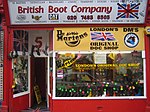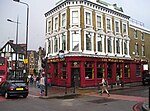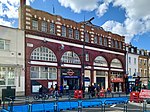Sainsbury's, Camden
Buildings and structures completed in 1988Grade II listed buildings in the London Borough of CamdenGrocery store buildingsHigh-tech architectureLondon Borough of Camden ... and 3 more
London building and structure stubsNicholas Grimshaw buildingsSainsbury's

Sainsbury's supermarket, Camden is an architecturally notable supermarket building in Camden Road, north London, and is part of the J Sainsbury chain. It was designed by Nicholas Grimshaw & Partners and was completed in 1988, on the site of the former Aerated Bread Company Camden Town bakery. In 2019 it became the first purpose built supermarket to be Grade II listed for its futuristic architecture.
Excerpt from the Wikipedia article Sainsbury's, Camden (License: CC BY-SA 3.0, Authors, Images).Sainsbury's, Camden
Camden Road, London Kentish Town (London Borough of Camden)
Geographical coordinates (GPS) Address External links Nearby Places Show on map
Geographical coordinates (GPS)
| Latitude | Longitude |
|---|---|
| N 51.5404 ° | E -0.1407 ° |
Address
Sainsbury's (Sainsbury's Camden Superstore)
Camden Road 17-21
NW1 9LJ London, Kentish Town (London Borough of Camden)
England, United Kingdom
Open on Google Maps









